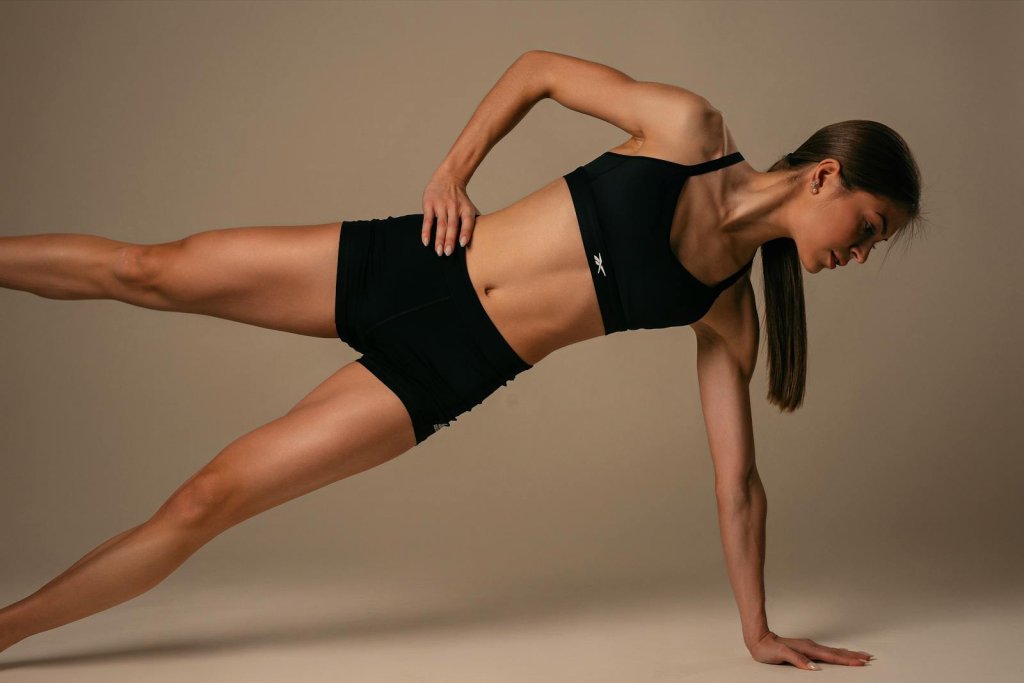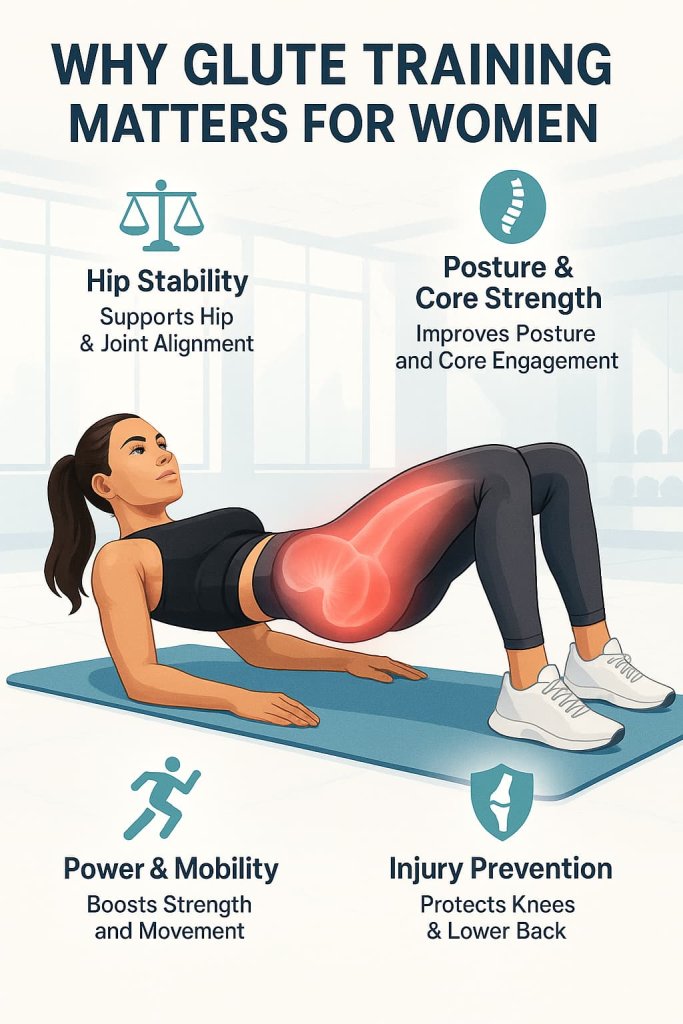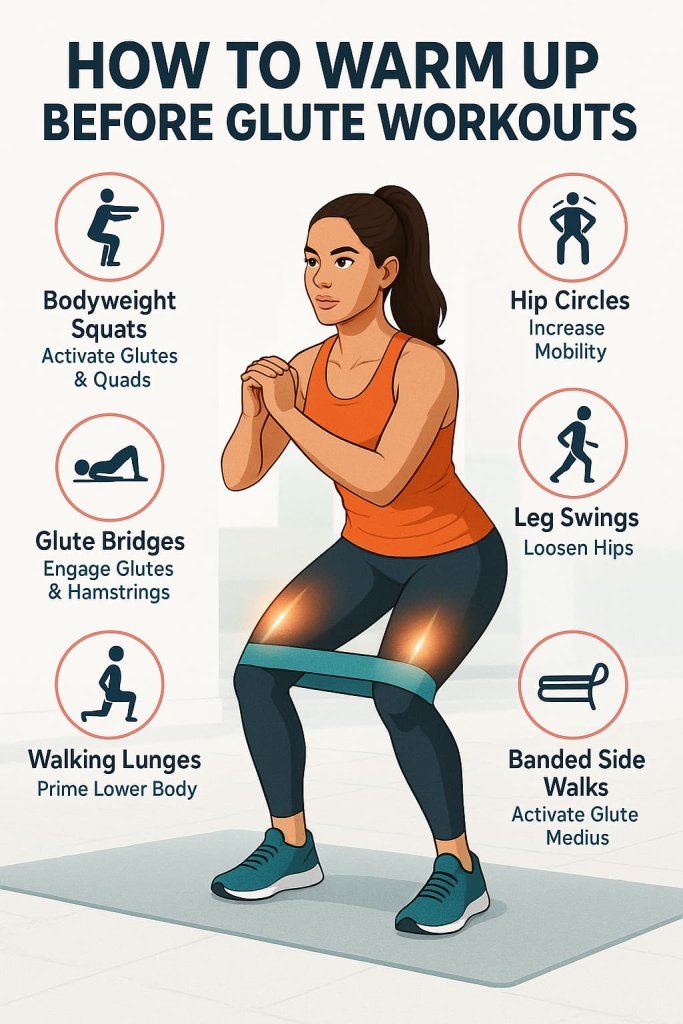The best glute exercises for women are those that target all three glute muscles — gluteus maximus, medius, and minimus — to lift, tighten, and sculpt your lower body.
Strong glutes don’t just enhance your curves — they improve posture, balance, and athletic performance while preventing lower back and knee pain. Understanding how to properly train your glutes helps you achieve lasting, visible results.

This guide covers the 17 most effective glute exercises for women, including science-backed moves and technique tips to help you lift, tone, and strengthen your booty safely and efficiently.
Why Glute Training Matters for Women
Research from Frontiers in Physiology (2025) found that resistance training produces a moderate but significant increase in gluteal muscle growth (SMD = 0.71) — meaning consistent, progressive overload is key to visible results.

Beyond aesthetics, strong glutes:
- Support hip stability and alignment
- Improve posture and core engagement
- Enhance athletic power and daily mobility
- Reduce the risk of knee and lower back injuries
How to Warm Up Before Glute Workouts

A 5–10-minute dynamic warm-up boosts blood flow, mobility, and glute activation.
Try: bodyweight squats, glute bridges, hip circles, leg swings, walking lunges, and banded lateral walks.
Trainer Tip:
Warm up just enough to feel your glutes activate — not fatigue — for better performance and injury prevention.
How to Structure Your Glute Workout Routine
| Level | Frequency | Sets | Reps | Rest |
|---|---|---|---|---|
| Beginner | 2–3 days/week | 2–3 | 12–15 | 60 sec |
| Intermediate | 3–4 days/week | 3–4 | 10–12 | 45–60 sec |
| Advanced | 4–5 days/week | 4–5 | 8–10 | 30–45 sec |
Trainer Tip: Combine compound lifts (like squats and hip thrusts) with isolation moves (like kickbacks and abductions) for balanced development.
17 Best Glute Exercises for Women
These 17 glute exercises for women target every angle of your lower body — lifting, shaping, and strengthening your glutes for a toned, sculpted look.
1. Barbell Hip Thrust
Why it works:
The most effective move for maximum glute activation through full hip extension. It isolates the glutes better than squats or deadlifts, making it a must-do for growth and shape.
Muscles worked:
Gluteus maximus, hamstrings, core.
How to do it:
- Sit on the floor with your upper back against a bench.
- Roll a barbell over your hips and plant your feet shoulder-width apart.
- Drive your hips upward until your body forms a straight line from shoulders to knees.
- Lower under control and repeat.
Trainer Tip:
Pause for two seconds at the top and squeeze your glutes hard before lowering to increase time under tension.
2. Glute Bridge
Why it works:
A beginner-friendly activation exercise that builds a strong mind-muscle connection and strengthens glutes before progressing to weighted versions.
Muscles worked:
Glutes, hamstrings, lower back.
How to do it:
- Lie on your back with knees bent and feet flat on the floor.
- Press through your heels to lift hips until your body forms a straight line.
- Squeeze glutes at the top, then slowly return to the floor.
Trainer Tip:
Add a mini resistance band around your thighs for greater activation and muscle control.
3. Bulgarian Split Squat
Why it works:
This single-leg powerhouse builds balance, strength, and symmetry while placing major emphasis on the glutes and quads.
Muscles worked:
Glutes, quads, hamstrings.
How to do it:
- Stand about two feet in front of a bench.
- Place one foot behind you on the bench.
- Lower your back knee toward the floor while keeping front knee over your ankle.
- Push through your front heel to rise back up.
Trainer Tip:
Keep your torso slightly forward and avoid locking your front knee to keep the glutes engaged.
4. Dumbbell Deadlift
Why it works:
Strengthens your entire posterior chain, improving posture, mobility, and overall lower-body power.
Muscles worked:
Glutes, hamstrings, lower back.
How to do it:
- Hold dumbbells in front of your thighs.
- Hinge at the hips, lowering weights toward the floor while keeping your back straight.
- Drive through your heels to stand tall and squeeze your glutes at the top.
Trainer Tip:
Avoid rounding your back. The movement should come from your hips, not your spine.
5. Step-Ups
Why it works:
This functional movement mimics everyday actions, helping build glute and leg strength while improving balance.
Muscles worked:
Glutes, quads, hamstrings.
How to do it:
- Step onto a sturdy bench or box with one foot.
- Push through your heel to lift your body up.
- Lower back down under control and repeat on the other side.
Trainer Tip:
Keep your chest lifted and engage your core to avoid leaning forward.
6. Cable Kickbacks
Why it works:
An isolation exercise that directly targets the gluteus maximus for shape, lift, and definition.
Muscles worked:
Glutes, hamstrings.
How to do it:
- Attach an ankle strap to a low cable pulley.
- Stand tall, brace your core, and extend one leg back in a controlled motion.
- Return to start without letting the weight pull you forward.
Trainer Tip:
Focus on squeezing your glutes at the top instead of swinging your leg for better isolation.
7. Banded Side Walks
Why it works:
Excellent for activating the outer glutes (glute medius), improving hip stability and preventing knee collapse.
Muscles worked:
Gluteus medius, gluteus minimus.
How to do it:
- Place a mini resistance band around your thighs or ankles.
- Bend your knees slightly and step side-to-side while keeping tension on the band.
Trainer Tip:
Stay low and controlled — avoid letting your knees cave in during each step.
8. Curtsy Lunge
Why it works:
Targets the outer glutes and inner thighs, promoting balance and roundness in the lower body.
Muscles worked:
Gluteus medius, adductors, quads.
How to do it:
- Step one leg diagonally behind the other.
- Lower into a lunge, keeping your chest upright.
- Push through the front heel to return to standing.
Trainer Tip:
Engage your core and keep the front knee aligned with the toes to prevent strain.
9. Frog Pumps
Why it works:
An intense finisher that isolates the glutes while minimizing quad engagement — great for glute growth.
Muscles worked:
Glutes, hamstrings.
How to do it:
- Lie on your back with soles of your feet pressed together, knees open wide.
- Thrust hips upward while squeezing glutes hard at the top.
Trainer Tip:
Perform high reps (20–30) for maximum burn and activation.
10. Sumo Deadlift
Why it works:
The wide stance shifts focus from lower back to glutes and hamstrings, helping build power and thickness.
Muscles worked:
Glutes, hamstrings, adductors.
How to do it:
- Stand wider than shoulder-width with toes slightly out.
- Grip the barbell between your legs and lift by driving hips forward.
Trainer Tip:
Keep knees tracking over toes and chest upright throughout the movement.
11. Kettlebell Swing
Why it works:
Builds explosive glute and hip power while improving endurance and athletic performance.
Muscles worked:
Glutes, hamstrings, core.
How to do it:
- Hold a kettlebell with both hands and hinge at the hips.
- Swing it between your legs, then explosively drive hips forward to swing it to chest level.
Trainer Tip:
Your hips, not your arms, should power the movement. Keep your core tight for control.
12. Lateral Step-Out Squat
Why it works:
Strengthens the outer glutes and thighs while improving balance and coordination.
Muscles worked:
Gluteus medius, quads.
How to do it:
- Hold a dumbbell at your chest.
- Step sideways into a squat, then return to the starting position.
Trainer Tip:
Avoid leaning forward — keep chest up and knees tracking over toes.
13. Reverse Lunge
Why it works:
More glute-dominant than forward lunges and easier on the knees.
Muscles worked:
Glutes, quads, hamstrings.
How to do it:
- Step one foot back and lower until both knees form 90-degree angles.
- Push through the front heel to rise back up.
Trainer Tip:
A slight forward lean increases glute activation without straining the back.
14. Standing Glute Kick
Why it works:
Perfect low-impact move to tone and tighten the glutes without equipment.
Muscles worked:
Glutes, hamstrings.
How to do it:
- Stand tall and hold onto a wall or chair.
- Kick one leg straight back, focusing on glute contraction.
Trainer Tip:
Keep the motion small and controlled — avoid using momentum.
15. Single-Leg Deadlift
Why it works:
Improves balance and stability while isolating each glute individually.
Muscles worked:
Glutes, hamstrings, core.
How to do it:
- Hold dumbbells and hinge forward on one leg, keeping your back straight.
- Extend the other leg behind you for balance, then return upright.
Trainer Tip:
Move slowly to stay balanced and maintain proper form throughout.
16. Squat to Lateral Leg Lift
Why it works:
Combines lower-body strength with outer-glute activation for a full sculpting effect.
Muscles worked:
Glutes, quads, glute medius.
How to do it:
- Perform a bodyweight squat.
- As you rise, lift one leg out to the side.
- Alternate sides with each rep.
Trainer Tip:
Focus on controlled leg lifts to avoid swinging and ensure glute engagement.
17. Donkey Kicks
Why it works:
Shapes and lifts the glutes while enhancing lower-back stability.
Muscles worked:
Gluteus maximus, hamstrings.
How to do it:
- Start on all fours with hands under shoulders and knees under hips.
- Lift one leg upward, keeping the knee bent at 90°.
- Lower slightly and repeat before switching sides.
Trainer Tip:
Engage your core and avoid arching your lower back for maximum glute isolation.
Trainer Tips for Faster Glute Growth
- Focus on mind-muscle connection — squeeze at the top of each rep.
- Progressive overload: Gradually increase resistance or reps weekly.
- Mix rep ranges: Combine heavy (8–10) and moderate (12–15) sets.
- Prioritize recovery: Rest 48 hours between glute-focused sessions.
- Maintain proper form to prevent injury and maximize activation.
Cool Down and Stretching Tips
Spend 5–8 minutes cooling down to reduce soreness and improve flexibility.
Try: pigeon pose, seated glute stretch, hamstring stretch, figure-4 stretch, and hip-flexor stretch.
Trainer Tip:
Hold each stretch for 20–30 seconds and breathe deeply to relax muscles and support recovery.
FAQ
1. How often should women train glutes?
2–4 times per week, depending on experience and recovery ability.
2. Can I train glutes without weights?
Yes — bodyweight moves like bridges, kickbacks, and band walks are very effective for beginners.
3. How long until I see results?
Typically 4–8 weeks of consistent training and proper nutrition.
4. What’s the best glute exercise for beginners?
Start with glute bridges and bodyweight squats before progressing to hip thrusts.
5. Should I do glute exercises before or after cardio?
Do them before cardio to ensure maximum strength and activation.
6. Do glute workouts make your thighs bigger?
Not necessarily — when performed correctly, they target the glutes more than the quads.
7. How can I prevent knee or back pain during glute exercises?
Keep a neutral spine, drive through heels, and warm up thoroughly before each session.
Conclusion
Building strong, sculpted glutes isn’t about luck — it’s about consistency, form, and progression. Incorporate these 17 best glute exercises for women into your weekly routine to lift, tone, and shape your booty fast while improving strength, stability, and confidence.
Start today — your strongest, most balanced self is waiting!
References
- Frontiers in Physiology (2025) — Glute Hypertrophy Meta-analysis
Gluteus maximus grows meaningfully with resistance training (supports your “best glute exercises” + progressive overload).
PubMed - Journal of Applied Biomechanics (2015) — Hip Thrust vs. Back Squat EMG
Shows higher glute activation in the barbell hip thrust—perfect evidence for your #1 exercise.
Human Kinetics Journals - ACSM — Dynamic Warm-Up Guidance
Authoritative support that dynamic warm-ups increase blood flow and prep joints/muscles (aligns with your warm-up H2).
ACSM - European Journal of Applied Physiology (2011) — Static vs. Dynamic Stretching Review
Foundational review recommending dynamic work pre-training; helps justify your pre-workout protocol.
ResearchGate - Frontiers in Physiology (2025) — Post-exercise Stretching Meta-analysis
Up-to-date evidence: post-workout static stretching has trivial, non-significant effects on soreness/performance—use mainly for ROM/relaxation in your cool-down H2.
frontiersin.org
